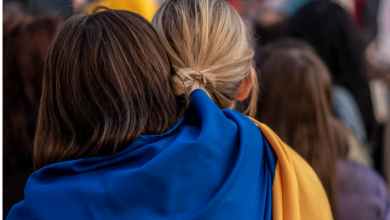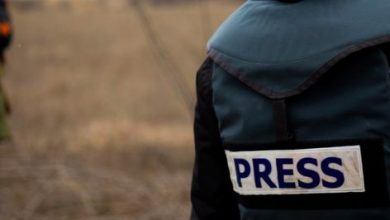Peace Journalism offers key to responsible refugee reporting

Steven Youngblood, 2023-24 Fulbright Scholar, Moldova
professor and director, Center for Global Peace Journalism, Park University (Missouri USA)
Media reporting about Ukrainian, Syrian, and other refugees is often overwhelmingly negative, and reinforces stereotypes while portraying refugees as threats. (See my earlier post “Media Stuck on Traditional Narratives about Refugees,” for details.)
For journalists, the challenge is to break out of traditionally negative narratives about refugees, and offer compassionate counter-narratives that debunk negative stereotypes while building bridges between the refugees and their host communities. Better, more productive media narratives around refugees from Ukraine and elsewhere are needed to “sustain public support in the critical months ahead, as the war is prolonged and expectations around an early resolution and return diminish,” in the words of a recent IOM report.
Peace journalism offers one prescription for enhancing and humanizing reporting about refugees.
Peace Journalism Basics
Let’s start with some definitions. In Peace Journalism (2005), Dr. Jake Lynch and Annabel McGoldrick define the concept as, “when editors and reporters make choices – of what to report, and how to report it – that create opportunities for society at large to consider and value non-violent responses to conflict.” Their definition goes on to say that PJ “uses the insights of conflict analysis and transformation to update the concepts of balance, fairness and accuracy in reporting.”
The Center for Global Peace Journalism based in Missouri, USA, adapts and expands on the Lynch/McGoldrick definition. The center says that PJ is a practice in which “editors and reporters make choices that improve the prospects for peace. These choices, including how to frame stories and carefully choosing which words are used, create an atmosphere conducive to peace and supportive of peace initiatives and peacemakers, without compromising the basic principles of good journalism. Peace Journalism gives peacemakers a voice while making peace initiatives and non-violent solutions more visible and viable.”
Just as important is a consideration of what peace journalism is not. None of PJ’s foundational literature states that peace journalism means open advocacy for peace, or that peace journalism ignores unpleasant, potentially inflammatory stories. News is news, and it must be reported. Thus, peace journalism asks how the news should be reported, how it should be framed, what words and images should be used, and how the event can be reported in a way that doesn’t exacerbate already dire situations, fuel violence, increase polarization, and make angry people angrier.
Two key elements of peace journalism are framing and word choice. The simplest definition of framing in journalism is the way journalists organize and present news. This includes which aspects of stories to emphasize, which to minimize, and which to ignore. In producing frames, media establish the meaning of an event, and help the public understand and categorize its importance. In Peace Journalism Principles and Practices (2016), it notes that, “Framing theory is significant for all journalists, but especially so for peace journalists, who often speak of narratives, which can be defined as the interpretation and presentation of a story. This (demonstrates) the power of media to create meaning and, thus, structure societal discourses.”
Another key to peace journalism is the importance of words and word choices. Peace journalists must be careful to avoid demonizing, victimizing, and inflammatory language because carelessly selected words can be anger-inducing, misleading, and divisive. In the case of refugees, such language can dehumanize and reinforce anti-migrant stereotypes.
There are many words that journalists regularly and carelessly use that add only negative emotion, but no substance, to a story. For example, how many people have to die for an event to become a massacre? Or how about the words “brutal,” “callous,” “slaughter,” “grim,” “monstrous”? What exactly constitutes a tragedy? And who is a martyr? This list includes demonizing language like “criminal,” “thug,” “liar,” and “evil.” The fact is that all of these words and their synonyms are subjective and imprecise. If a peace journalist is to adhere to the principles of objectivity and impartiality, and if these emotive words are inherently subjective, this alone should be sufficient reason to limit the use of such language.
Now that we understand the basics, let’s discuss how these ideas apply to coverage of refugees.
Applying Peace Journalism to reporting about refugees
The goal of any journalist reporting about refugees should be to accurately portray their situation and circumstances while rejecting exclusively negative narratives that reinforce stereotypes. At its best, such reporting could even build bridges between refugees and their host communities. At minimum, coverage must not exacerbate already bad situations by stigmatizing refugees or straining relations between refugees and their host communities.
Story framing and word choice are good places to begin for reporters to begin analyzing their own refugee reporting. Regarding framing, is the story framed so that refugees are presented only as a problem or a burden? Are refugee voices included in the coverage? As you recall in my first blog, I presented study data that show that many refugee stories interview only officials, and not refugees themselves. Better framing would include refugee voices, give voice to problems and solutions as identified by refugees, and produce counternarratives the debunk exclusively negative narratives that portray refugees only as a burden, as carriers of disease or as criminals.
Regarding word choice, do the words used dehumanize refugees? For example, research has shown that “problematic” migrants as water metaphors are frequently used. According to researchers, these dehumanizing words include “flood,” “flux,” “surge,” “tide,” and so on. Other problematic terms include “invaders” and “under siege.” (Peace Journalism Principles and Practices)
During a 2015 reporting refugees workshop in Turkey, the journalists participating and I developed the list below of do’s and don’ts for journalists covering refugees and other migrants.
When reporting refugees and other migrants, journalist should:
1. Consider the consequences of your reporting. Ask what impact could the interview/story have on:
a. The refugee/migrant’s well-being;
b. The well-being of the migrant’s family/associates back home;
c. The well-being of other migrants;
d. The ability of NGO’s/aid agencies to meet migrants’ basic needs.
2. Give more leeway in granting anonymous or first name only interviews, since displaced persons and their families may face persecution or even violence if their identities are revealed.
3. Be sympathetic, and ease into discussions about traumatic or sensitive events. Take special care not to re-traumatize victims. (The Dart Center has excellent resource materials on responsibly reporting about refugees and others who have been traumatized.)
4. Avoid spreading propaganda, regardless of the source. Even refugees and those who serve them have an agenda.
5. In refugee camps and settlements, be especially careful to avoid spreading rumors, and be vigilant about squashing false rumors. (Imagine the impact, for example, of a rumor that food deliveries are being cut off, or that Ebola is present in the camp). This is especially true for social media.
6. Don’t use language or images that rely on or reinforce stereotypes, racism, sexism, or xenophobia.
7. Always ask permission before taking any photograph.
8. Proactively investigate and report refugee stories that offer counter-narratives that debunk stereotypes and challenge exclusively negative narratives.
9. Partner with and employ reporting partners who are themselves displaced or migrants.
10. Humanize individuals and their stories. Look for examples that illustrate larger statistics or trends. (Center for Global Peace Journalism)
A handbook by the Independent Journalism Center and Internews highlights some of these same suggestions. It cautions reporters against stereotyping or stigmatizing and advises them to take extra care to let the refugee know who you are and what your purpose is. Further, it counsels reporters to be especially careful when reporting children (see UNICEF guidebook); to consider the impact and consequences of the interview; and to look after oneself as a journalist.
Further advice comes from Irina Stryapko, a Ukrainian journalist exiled in Moldova. In Media Azi, she asks journalists writing refugee stories to not “over-dramatize” events, and use “more facts and less emotions.” Also, she advises broadening coverage. Stryapko writes, “The problem with the present-day media is that the refugee crisis and the war are covered in waves, and the peak of interest is fleeting. We need to get back to people’s stories after a while, to show how their life has changed in the new country, how they have found new jobs and received their documents, and how they have felt during the adaptation period.”
Other organizations have made similar recommendations on improving refugee reporting. These include a eight practical tips from the European Federation of Journalists, and guidelines for refugee reporting from UNHCR.
Peace journalism and refugee reporting in action
A number of peace journalism projects have sought to enhance reporting about refugees.
In Turkey, the Center for Global Peace Journalism teamed up with Istanbul University and the U.S. Consulate in Istanbul to sponsor a project to address the one sided, xenophobic reporting by Turkish media. The 2015 project was called, “Reporting Syrian Refugees: Building Communities of Understanding.” According Professor Nilufer Pembecioglu, co-director of the initiative, the project included encouraging and nurturing a more stable peace between host communities and refugees while it empowering local journalists to employ peace journalism tools that foster reconciliation and discourage division and violence.
There were several project components. It began with two seminars in Adana, in southern Turkey. Instruction included both classroom sessions (how peace journalism-style storytelling seeks to add depth and context to reports about refugees) and field work. Participants included local journalists and journalism department staff and students of Cukurova University in Adana. The seminars included visits to the refugee camps and tent cities to produce stories that “help host communities understand the scope of the crisis,” according to Professor Pembecioglu.
For Professor Pembecioglu, the most important aspect of the Adana seminars was field reporting done in both formal refugee camps and informal tent cities housing Syrians. “For both the practicing and future journalists, it was interesting to feel the camp life, observe the facilities and daily life, and experiencing the hopes and fears of the real refugees. The participants found out the impact of displacement on social and economic lives of the refugees.” (Peace Journalism Principles and Practices)
Similar projects were conducted elsewhere. The Center for Global Peace Journalism and the Media Association for Peace sponsored several seminars and workshops in Lebanon in 2013, one of which asked the participants to venture into the streets of Beirut to tell the story of Syrian refugees living there. Likewise, trainings by the Center for Global Peace Journalism in Germany and Austria in 2015 sought to improve predominantly negative (refugees as freeloaders), one dimensional reporting about refugees.
In Uganda, the Refugees Online News Network (RON) is applying PJ principles to field reporting about refugees. RON is “a collaborative multimedia online news outlet highlighting the situation of the 1.2 million refugees from seven African countries living in Uganda. Through this online news platform, they encourage writing and publishing of articles about the situation of rural and urban refugees. RON’s main goal is to “prevent social and traditional media-induced violence by applying peace journalism styles in reporting about refugees,” according to their website. RON has covered stories including the struggle to find food and clean water, Covid, and the need for counternarrative reporting.
Conclusion
Refugees and other migrants are especially vulnerable. As journalists, we would be well served to remember this, and treat them more carefully than we might other sources. Remember the trauma that they have been through, and use your humanity, as well as the principles of peace journalism, to inform your interactions with and reports about refugees.



